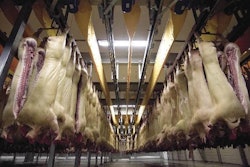As the rate of growth of Asia's poultrymeat industries outstrips the world average, this region is capturing a greater share of global output.
Currently Asia produces in excess of 31 million tonnes of poultrymeat a year, which represents 34 percent of the global total.
 0809PIasia
0809PIasia
This is also an important trading area with annual imports of poultrymeat approaching 5mt or about 50 percent of the business, though when it comes to exports, the region is less important with annual sales amounting to almost 1.5mt or 16 percent of the world total.
Although outbreaks of highly pathogenic avian influenza (HPAI) have applied a brake to the rate of growth in chicken-meat production during the past few years, expansion over the region as a whole has still managed to outstrip that achieved worldwide. Consequently, this region has captured an increasing share of global output. Ten years ago, chicken-meat production in Asia amounted to just over 16mt or 31.5 percent of the global total. This year output will come close to 26mt or about 34 percent.
Between 1997 and 2007, the average annual growth for the region was almost 4.5 percent compared with less than 4 percent globally. All five regions (Table 1) recorded significant gains over the period reviewed, ranging from an annual average of about 3.3 percent in South-east Asia to nearly 9 percent in Southern Asia.
China dominates output
With China positioned in Eastern Asia, it is not surprising to find that this is easily the largest producing region with an annual chicken-meat output of an estimated 12.7mt in 2007.
It is important to note when appraising any data that the degree of reliability depends on the accuracy of the information. The magnitude of errors will vary between countries and could range as widely as plus or minus 20 percent in poor, less developed countries to plus or minus 5 percent in developed economies. On the assumption that the error in the data for a country is roughly the same over a period of time, the trend of the figures will often be more important than the absolute numbers.
Table 2: Poultry meat production in mainland China (000 tonnes)
China is the world's second-largest poultrymeat producer, after the US. The figures for China can be confusing on two counts. Firstly, because of a failure to distinguish between chicken meat and poultry meat as the latter includes around 2.5mt of duck meat and about 2.3mt of goosemeat and guineafowl meat. And secondly, it may not be clear that the data relates solely to mainland China and does not include Taiwan.
According to the Food and Agricultural Policy Research Institute (FAPRI), broilermeat output in mainland China in 2007 amounted to 10.85mt. However, while the FAO's estimate for China is almost identical, the figure includes Taiwan, which produces around 600,000t a year. By 2017, FAPRI expects broilermeat output in mainland China to reach around 14.4mt.
As per USDA data, China's broiler production is likely to increase 9 percent this year to 12.5mt as a consequence of a strong domestic demand as consumers switch to chicken from pork, which has become more expensive as supplies have dwindled as a result of swine blue ear disease. This market situation will also result in an increase in chicken imports (excluding paws), which are forecast to reach 600,000t this year compared with nearly 500,000t in 2007. By 2017, broilermeat imports are expected to hit almost 700,000t. Currently, China also imports about 550,000t of chicken paws a year, though the figure is projected to exceed 700,000t this year.
On the consumption front, pork has steadily lost ground to other meats and in particular poultry, especially chicken. In the early 1980s, poultrymeat uptake represented around 8 percent of all meat at 1.13kg/person/year. But, by 2006 these figures had increased to 13 percent and 11.2kg respectively, of which 8kg was chicken meat.
Other regional drivers
Two other leading producers in this region are Japan and the Republic of Korea.
Production in Japan has shown little movement over the years, around an average of 1.3mt.The outlook points to a slight decline in the next decade with a commensurate increase in imports, which currently stand at around 700,000t a year.
Although smaller than the other two, chicken production in the Korean Republic has risen by more than 40 percent since 1997 to an estimated 525,000t in 2007 and FAPRI forecasts that it will grow to almost 600,000t by 2017.
The country showing the most dramatic expansion is in Southern Asia, namely India. Production has almost quadrupled since 1997 to reach 2.2mt last year, while FAPRI forecasts further increases of around 2.5 percent a year, yielding close to 2.9mt by 2017.
Information on Iran is hard to come by but output appears to have more than doubled in the past decade.
In South-east Asia, after setbacks in the late 1990s, Indonesia's chicken-meat industry has exhibited fairly rapid growth with output expected to exceed 1.3mt last year. As with almost all other industries, the rate of expansion is expected to slow in the decade ahead, and currently HPAI continues to pose problems. The chicken population comprises about 69 percent conventional broilers, 21 percent native table birds and 7 percent layers. While FAPRI foresees a near 30 percent increase in broiler production by 2017 to more than 900,000t, other forecasts seem to indicate that this could be at the expense of native birds and that total chicken-meat output may not rise by much more than 6 percent.
The Thai comeback
Bans on fresh chicken exports after outbreaks of HPAI in 2004 forced Thailand's industry to switch to exporting cooked products. As a result, output has staged a recovery over the past three years, once again, topping a million tonnes in both 2006 and 2007. The forecast for 2017 is 1.5mt. Thailand's exports of cooked chicken are expected to expand again this year by at least 10 percent, in line with a strong demand from the European Union and Japan.
Also, it is believed that similar products from China will become less competitive as a result of higher prices in that country, and some concerns over product quality.
Thailand is trying to convince major importing countries to accept the concept of compartmentalisation which would allow it to export raw/uncooked chicken again from approved companies, regardless of the country status of AI. The World Animal Health Organisation (OIE) initiated this concept as a way to facilitate safe and fair international trade. Two integrated companies are said to have qualified for such a compartmentalisation audit.
In Western Asia, Turkey's expansion since 1997 is of note, although production has stagnated at a little below the million-tonne mark in the past three years. It is hard to say to what extent outbreaks of HPAI have had a hand in this.
Despite further growth in Saudi Arabia with production likely to approach 700,000t by 2017, imports are forecast to rise over the next 10 years from the current level of around 450,000t to almost 650,000t a year.


















